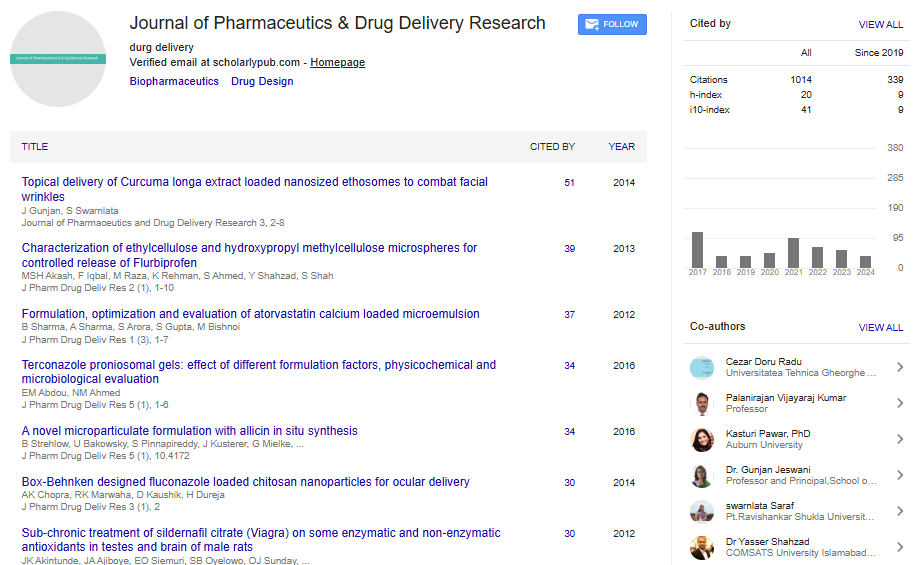Mesoporous alginate nanofiber mesh enhancing cell movement in the scaffold
Young Ju Son, Wei Mao, Myun Koo Kang, Sol Lee, Ji Un Shin and Hyuk Sang Yoo
Kangwon National University, Republic of Korea
: J Pharm Drug Deliv Res
Abstract
Cell cultivation on the electrospun meshes is often restricted to 2D cultivation because nonwoven mesh structure is hard to penetrate by cell itself. Instead of solid ground for depositing nanofiber, liquid ground and ball shape ground were introduced and showed low density of sponge nanofiber mesh. Hydrophilic polymer, however, is limited to use independently in electrospun nanofiber that rapidly dissolved out in water without further crosslinking process. Herein, we developed gelatin nanofiber for enhancing cell infiltration with loosen-fiber network and hydrophilicity of the mesh for three dimensional cell proliferations. We used electrospun alginate (core) and poly (ε-caprolactone) (PCL) (shell) using co-axial nozzle. The alginate in the nanofiber was subsequently crosslinked in various concentration of CaCl2 solution and PCL was removed in chloroform. Morphology, water swelling ratio, elastic modulus of single and multiple nanofiber and NIH3T3 cell migration in the alginate mesh were characterized according to calcium crosslinking density of the alginate nanofiber. With decreasing calcium concentration (AL@NFhigh to AL@NFmid), alginate was not fully cross-linked and dissolved out after washing in distilled water showing lower fiber density. Thereby, AL@NFmid has significantly higher swelling ratio by synergy of hydrogel property of single fiber (hydro-nanofiber) and enhanced porous structure of the mesh. Mechanical property of single nanofiber and nanofiber mesh of AL@NFhigh was stiffer and more elastic than AL@NFmid. NIH3T3s migration in fibronectin treated alginate mesh and Gel2 (2% calcium treated alginate gel, 3D control) was vertically visualized for 5 days. Interestingly, cells were rapidly moved in AL@Hydro-NFhigh up to 800 μm depth. On the other hand, AL@Hydro-NFmid with larger space in the mesh than AL@Hydro-NFhigh showed less cell migration and cells were rarely migrated in Gel2. We speculate that AL@Hydro-NFhigh mesh was favorable for initial cell binding and focal adhesion that was clearly confirmed at day 1.
Biography
Young Ju Son has received her BS and MS degree from Kangwon National University, Republic of Korea in 2010 and 2012, respectively. She is presently focusing in the fields of biomedical materials in her Doctorial course in the Graduate School of Kangwon National University, Republic of Korea. She has great interests in therapeutic delivery, including drug and gene delivery, using metal materials such as gold nano-carriers, for immunotherapy and tumor targeting and tissue engineering using biodegradable materials such as polymeric nanofibers for advance cell cultivation.
Email: sonmong922@kangwon.ac.kr
 Spanish
Spanish  Chinese
Chinese  Russian
Russian  German
German  French
French  Japanese
Japanese  Portuguese
Portuguese  Hindi
Hindi 
